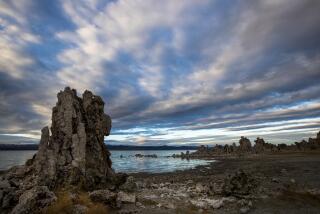DROPPING WATERLINE AT MONO LAKE
- Share via
Consequences for aquatic plants and animals at varying lake depths, according to the National Research Council of the National Academy of Sciences:
At 6,430 feet above sea level (historic high in 1919): Plankton and algae flourish, as do brine shrimp and brine flies. Migrating grebes and Wilson’s phalaropes--types of birds--stop at lake to feed and molt; California gulls breed.
At 6,380 feet (present level): Grebes begin to leave the lake earlier; Wilson’s phalaropes find it difficult to complete molt, and red-necked phalaropes’ stopover is shortened.
At 6,360 feet: Plankton productivity reduced, brine shrimp hatch is reduced, brine fly larvae show modest decrease in growth. Grebes’ stopover period at lake is shortened even more. Phalaropes drop Mono Lake as major stopover site. Number of breeding gulls is sharply reduced and their reproduction lowered because of a lack of food.
At 6,330 feet: Large decrease in all types of algae productivity. Loss of brine shrimp and brine fly except for small populations located near where fresh water is present. Grebes drop Mono Lake as a stopover site. Few gulls breed; those remaining depend largely on food resources distant from Mono Lake.
More to Read
Sign up for Essential California
The most important California stories and recommendations in your inbox every morning.
You may occasionally receive promotional content from the Los Angeles Times.













